Enhanced sensitivity to naltrexone-induced drinking suppression of fluid intake and sucrose consumption in maternally separated rats
- PMID: 17459462
- PMCID: PMC2075100
- DOI: 10.1016/j.pbb.2007.03.007
Enhanced sensitivity to naltrexone-induced drinking suppression of fluid intake and sucrose consumption in maternally separated rats
Abstract
Early-life stress has been identified as a risk factor in the development of a host of disorders, including substance abuse; however the link between early postnatal stress and changes in measures of reward has not been thoroughly researched. The current study had two main objectives: 1) to determine the impact of maternal separation (an animal model of early-life stress) on the consumption of 10% and 2.5% sucrose solutions by Long-Evans rat dams and male and female offspring, and 2) to determine the effect of the opioid antagonist naltrexone (0.1-3.0 mg/kg) on drinking by each of those groups. Dam-pup separations occurred for varying lengths of time during the first two postnatal weeks. In Experiment 1, a two-bottle choice test (sucrose solution vs. water) was administered across five days to both nonhandled (NH) and maternally-separated (MS) offspring as adults and to dams 2-4 weeks post-weaning. In Experiment 2, naltrexone was administered prior to two-bottle choice tests. MS males and the dams of MS litters exhibited increased intake of total fluid and sucrose solutions, whereas results from females were less consistent. Naltrexone elicited a greater decrease in fluid intake and sucrose intake in male MS offspring compared to male NH offspring. These results indicate that early postnatal stress alters both sucrose consumption, a non-drug measure of reward, and apparently the brain opioid systems that mediate naltrexone-induced drinking suppression.
Figures
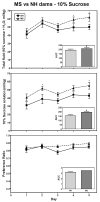

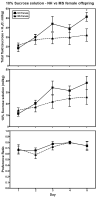
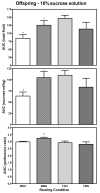
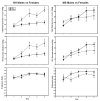
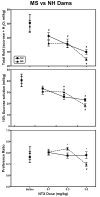
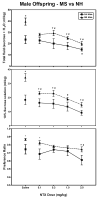
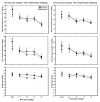
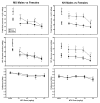
Similar articles
-
Neonatal stress and litter composition alter sucrose intake in both rat dam and offspring.Physiol Behav. 2006 Dec 30;89(5):735-41. doi: 10.1016/j.physbeh.2006.08.015. Epub 2006 Sep 22. Physiol Behav. 2006. PMID: 16996094
-
Maternal separation alters ICSS responding in adult male and female rats, but morphine and naltrexone have little affect on that behavior.Brain Res Bull. 2007 Jul 12;73(4-6):310-8. doi: 10.1016/j.brainresbull.2007.04.008. Epub 2007 May 22. Brain Res Bull. 2007. PMID: 17562397
-
Endogenous opioids are necessary for benzodiazepine palatability enhancement: naltrexone blocks diazepam-induced increase of sucrose-'liking'.Pharmacol Biochem Behav. 2005 Jul;81(3):657-63. doi: 10.1016/j.pbb.2005.05.006. Pharmacol Biochem Behav. 2005. PMID: 15961147
-
Effect of naltrexone on human alcohol consumption.J Clin Psychiatry. 1995;56 Suppl 7:24-9. J Clin Psychiatry. 1995. PMID: 7673102 Review.
-
NIEHS Report on the Toxicity Studies of Nicotine Bitartrate Dihydrate (CASRN 6019-06-3) Administered in Drinking Water to Sprague Dawley Rats and Swiss Mice: NIEHS Report 11 [Internet].Research Triangle Park (NC): National Institute of Environmental Health Sciences; 2024 Oct. Research Triangle Park (NC): National Institute of Environmental Health Sciences; 2024 Oct. PMID: 39441944 Free Books & Documents. Review.
Cited by
-
Neuropeptides as mediators of the early-life impact on the brain; implications for alcohol use disorders.Front Mol Neurosci. 2012 Jul 5;5:77. doi: 10.3389/fnmol.2012.00077. eCollection 2012. Front Mol Neurosci. 2012. PMID: 22783165 Free PMC article.
-
Adult food choices depend on sex and exposure to early-life stress: Underlying brain circuitry, adipose tissue adaptations and metabolic responses.Neurobiol Stress. 2021 Jun 28;15:100360. doi: 10.1016/j.ynstr.2021.100360. eCollection 2021 Nov. Neurobiol Stress. 2021. PMID: 34277896 Free PMC article.
-
Discriminative stimulus properties of naloxone in Long-Evans rats: assessment with the conditioned taste aversion baseline of drug discrimination learning.Psychopharmacology (Berl). 2009 Apr;203(2):421-9. doi: 10.1007/s00213-008-1233-5. Epub 2008 Jul 2. Psychopharmacology (Berl). 2009. PMID: 18594795 Free PMC article.
-
Neonatal maternal separation exacerbates the reward-enhancing effect of acute amphetamine administration and the anhedonic effect of repeated social defeat in adult rats.Neuroscience. 2010 Nov 10;170(4):1189-98. doi: 10.1016/j.neuroscience.2010.08.002. Epub 2010 Aug 5. Neuroscience. 2010. PMID: 20691770 Free PMC article.
-
Early life stress paradigms in rodents: potential animal models of depression?Psychopharmacology (Berl). 2011 Mar;214(1):131-40. doi: 10.1007/s00213-010-2096-0. Epub 2010 Nov 18. Psychopharmacology (Berl). 2011. PMID: 21086114 Review.
References
-
- Arellano CM. Child maltreatment and substance use: A review of the literature. Subst Use Misuse. 1996;31:927–935. - PubMed
-
- Baker RW, Li Y, Lee MG, Sclafani A, Bodnar RJ. Naltrexone does not prevent acquisition or expression of flavor preferences conditioned by fructose in rats. Pharm Biochem Behav. 2004;78:239–246. - PubMed
-
- Beczkowska IW, Bowen WD, Bodnar RJ. Central opioid receptor subtype antagonists differentially alter sucrose and deprivation-induced water intake in rats. Brain Res. 1992;589:291–301. - PubMed
-
- Berridge KC, Robinson TE. Parsing reward. Trends Neurosci. 2003;28:507–513. - PubMed
-
- Brady KT, Verduin ML. Pharmacotherapy of comorbid mood, anxiety, and substance abuse disorders. Subst Use Misuse. 2005;40:2021–2041. - PubMed
Publication types
MeSH terms
Substances
Grants and funding
LinkOut - more resources
Full Text Sources

